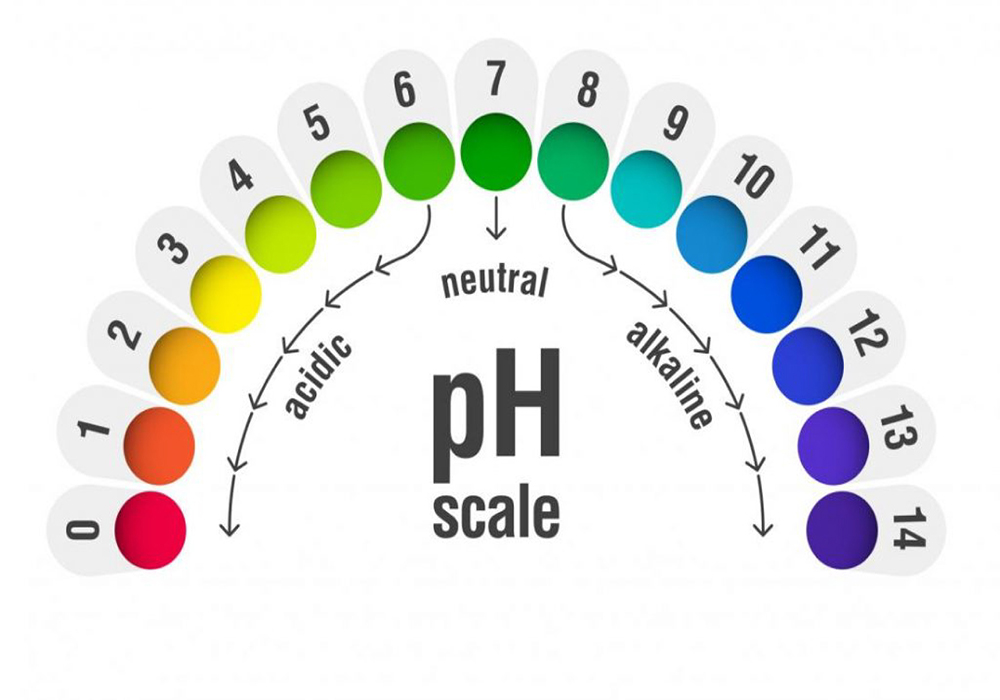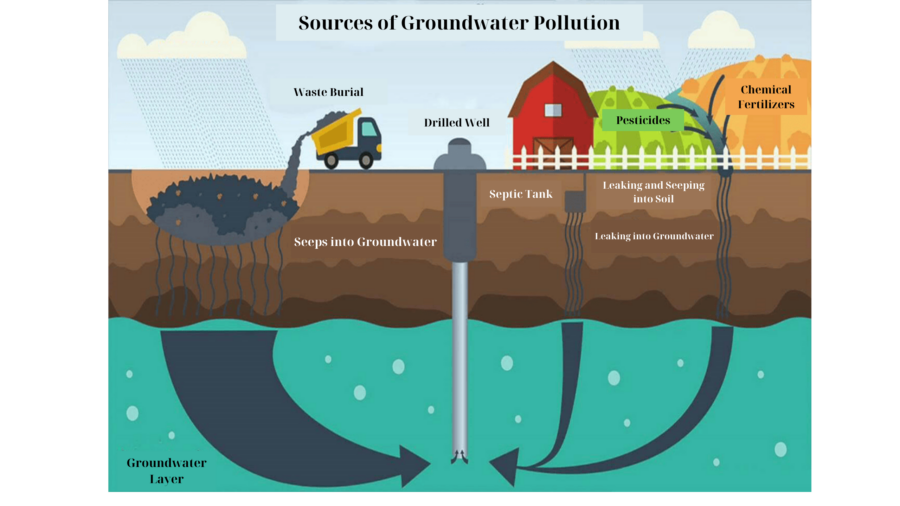You may turn on the tap expecting clean, refreshing water, but the water tastes bitter, has a strange odor, or contains small rust particles, which may indicate acidic well water.

What is acidic or low pH water?
To better understand the concept of acidity, let’s start by defining the term “pH.” You may remember it from science class, but if not, think of pH as a scale that measures the concentration of hydrogen ions in a substance, or more simply, how acidic or alkaline (basic) a liquid is.
The pH scale ranges from 0 (most acidic) to 14 (most basic). Right in the middle, at 7, water is pure and is considered “neutral” because it is neither acidic nor basic. Water with a pH below 7 is acidic. The lower the number, the more acidic it is. Conversely, water with a pH above 7 is alkaline. The higher the number, the more alkaline the water is.
The Environmental Protection Agency (EPA) recommends that drinking water maintain a pH between 6.5 and 8.5 to prevent the negative effects that pH that is too high or too low can cause.
What causes well water to be acidic?
If well water is neutral, how can it become acidic? Several factors can tilt the pH of water toward acid; some are natural, while others are due to human activity.

Natural process
As groundwater moves underground, it can absorb naturally occurring acidic compounds stored in the soil and bedrock, such as iron, manganese, or carbon dioxide (CO2). Once dissolved in water, these compounds cause the pH of the water to drop, increasing acidity. Decomposing plant material or organic waste in the soil can also release ammonia and other nitrogen compounds into the water and cause CO2 to accumulate, further lowering the pH of the water.
Acid rain is another common contributor. This environmental phenomenon occurs when pollutants such as sulfur dioxide (SO2) and nitrogen oxides (NOx) in the atmosphere mix with rain, snow, or fog, forming sulfuric acid (H2SO4) and nitric acid (HNO3). Once these acids reach the ground, they can leach minerals such as copper and aluminum from the soil, increasing the acidity of the water as it travels to underground aquifers that feed wells. Some geological formations, such as limestone or dolomite, have unique chemical properties that naturally lower the pH of water as it passes through them.
Man-cause pollution
Human activities such as agricultural and industrial pollution can also affect the pH of well water. For example, farmers and gardeners often use chemicals such as fertilizers and pesticides to provide nutrients to plants and crops and to repel pests. However, many people are unaware of the dangers of these compounds in well water. Some fertilizers and pesticides contain nitrogen compounds that can undergo nitrification in the soil, resulting in the formation of acidic or basic compounds that can lower the pH of groundwater and make it acidic.
Industrial activities such as mining, coal burning, and quarrying can also release acidic compounds into surrounding soils and surface waters, which can enter groundwater supplies and increase their acidity.
Is acidic well water safe to drink?
While acidic well water is not a health hazard, it is known to leach heavy metals that corrode pipes and plumbing, increasing the amount of copper, lead, iron, and other metals in the water, many of which can be harmful to your health.
While healthy in small doses, exposure to high levels of zinc and copper can lead to a variety of gastrointestinal issues such as nausea, vomiting, and diarrhea. Long-term overconsumption can lead to serious health complications, including nerve damage, kidney stones, gallstones, and even kidney and liver failure.
Lead is especially dangerous for children. Because children’s bodies develop more rapidly than adults, they absorb contaminants more easily. Lead exposure in the fetus can cause premature birth, low birth weight, and developmental delays. Young children can suffer from anemia, low IQ, hearing loss, learning disabilities, attention deficit disorder (ADD), brain and nervous system damage, and physical and mental delays. In adults, lead exposure can lead to miscarriage, stillbirth, nervous system damage, stroke, kidney disease, high blood pressure, and cancer.
If your water contains high levels of iron, you may experience health complications, including stomach upset, constipation, nausea, abdominal pain, vomiting, and diarrhea. Large amounts of iron can also cause more serious effects, including inflammation of the stomach lining and ulcers.
Exposure to heavy metals, including lead, cadmium, arsenic, and chromium, has been linked to adverse effects on bone health. Furthermore, beverages with a pH of 4.5 or lower have been shown to increase the risk of tooth decay. For example, regularly drinking acidic water can gradually erode your tooth enamel, causing cavities.
So, if you are a private well owner, it is best to monitor the pH of your well water and take necessary measures.
How do I know if my well water is acidic?
Acidic water can cause a variety of aesthetic problems in your home, such as the following:
The inside of your sink or toilet is corroded
One of the first places you’ll see signs of acidic water is inside the toilet bowl or sink. Because water sits there for so long, corrosion becomes more apparent. So your water may be acidic if you see flaky, rust-colored deposits or pitting and corrosion on the tank’s surface.
Noticeable green stains on your copper plumbing
Because water is highly acidic, it can dissolve copper from pipes and plumbing fixtures. As the water evaporates, it can leave behind stains wherever it comes into contact with plumbing fixtures. If you have copper pipes, you may notice blue stains in and around tubs, sinks, drains, and other fixtures. This is an aesthetic issue and a sign that your pipes are rusting, which can lead to other problems.
Red rust stains in the cast iron plumbing system
Cast iron is also used in many plumbing systems, but like copper, it is susceptible to the harsh effects of acidic water. When these pipes come into contact with acidic well water, they can corrode, leaving red rust stains around pipe joints, fixtures, etc. As you can imagine, this doesn’t look very pretty. But perhaps worse, it indicates that your pipes or entire plumbing system is deteriorating and may need to be repaired or replaced soon.
Leaking in your water system
When well water is acidic, it corrodes metal pipes and plumbing from the inside out, causing pinholes to develop. So if you notice a leak that gets worse over time, your water pH may have dropped to acidic levels.
Your water tastes bitter and metallic
No one wants their drinking water to taste like it’s mixed with metal crystals and vinegar. And that’s exactly what acidic well water tastes like. This common bitter metallic taste comes from metal particles that leach into the water from pipes and plumbing as it travels to your tap.
Your water appliances are not working properly
If your water-using appliances are breaking down more often than usual, acidic water may be the culprit. Like pipes and plumbing, water acidity can corrode the internal components of water heaters, washing machines, and dishwashers. Over time, these appliances lose efficiency, use more energy, and eventually break down prematurely, requiring more frequent repairs or replacements.
While it helps to recognize the signs of low pH in well water, it is important to test your water to see if it is acidic.
How to measure acidity in well water
Measuring the pH of your well water is fairly straightforward. We recommend three methods for well owners, each with different levels of accuracy and price.
- Digital pH Meter: A digital pH meter is a small, handheld device that measures the acidity or alkalinity of water. To test the pH of water, carefully place the probe into the water sample, press the measure button, and wait for the reading to stabilize. Remove the probe from the water and rinse it with distilled or deionized water before next use.
- pH Test Kits: pH kits are typically more affordable than digital meters but are generally less accurate. They are commonly available online, at pool supply stores, and many hardware stores. Using a pH test kit is fairly simple—dip the test strip into a cup of water, wait a few seconds, and compare the color of the strip to a color chart. Unlike digital meters, pH kits typically do not provide an exact measurement of the pH of your water, but only a range.
- Lab Testing: The most reliable and accurate way to determine the pH of your water is to send a sample to a state-certified lab for testing. While this option can be more expensive and can take a few days to a week to get results, the accuracy is well worth it. Water testing labs are also ideal for identifying contaminants that standard test kits may not detect. So a professional lab may be the most practical option if you have other water quality concerns. But if you just need a quick pH reading, you’re better off with a pH meter or digital meter.
The Best Way to Treat Acidic Well Water
If testing shows your well water has a pH below the EPA-recommended 6.5 – 8.5, consider installing an effective acid neutralization filter.
Unlike water softeners that remove calcium and magnesium from water to reduce hardness, acid neutralizers introduce these minerals into water to increase pH. pH neutralizers, as they are also called, are typically installed where water first enters your home. This ensures that the system raises the pH of the water before it can cause harm to your home’s plumbing system.
See more: 6 Practical Ways To Reduce Water Pollution At Home
To learn more about other powerful and unique water filtration systems distributed by Song Phung, order online at the website https://thietbinganhnuoc.com/san-pham or call our hotline 0913.90.72.74 – 0984.620.494 for further inquiry.
Follow Fanpage: https://www.facebook.com/SongPhungthietbinganhnuoc/ to be updated with new products.
Translator: Duong Nguyen Hoang Khang


